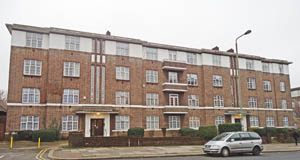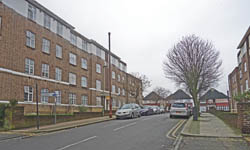First
Home of Recovery
Highfield,
Golders Green, NW11
Medical
dates:
Medical
character:
Rehabilitation
In 1917 the Maida Vale Hospital for Nervous Diseases
arranged with the Ministry of Pensions to create a Home of
Recovery for discharged soldiers and sailors suffering from
neurasthenia and other functional disorders of the nervous system.
The British Red Cross Society leased Highfield, a former girls' boarding
school with extensive grounds in Golders Green, for £500 a year,
while the Ministry of Pensions agreed to pay the running costs.
The First Home of Recovery opened in June 1917 with 100 beds, after some £6,000 was spent on putting the premises in order.
The first patients had already been in their own homes for some time, but later discharged servicemen were received directly from military hospitals. They were allowed to stay at the Home for three months and, during this time, they received electrical treatment, physiotherapy (including whirlpool baths) and psychotherapy.
The staff consisted of two Resident Medical Officers, a Matron, four Sisters and six staff nurses. The night staff consisted of a Sister and two nurses, as patients who had been well during the day were likely to have disturbing symptoms recur during the night.
The ground floor rooms were spacious and lofty, and all had French windows opening out to the gardens. One was used as a dining room, furnished with small tables - a generous diet was part of the treatment. The men were allowed to sit where they liked, and also could share bedrooms with whomsoever they wished. A covered south-facing verandah was allocated as the Smoking Room, where the patients could watch their more energetic companions at work in the gardens or at sport.
The Ministry of Pensions paid each single man 27s 6d (£1.37) a week. Married men also received the same amount, while their wives received 13s 9d (£0.69) a week, and an allowance of 5s (£0.25) was given for the first child, 4s 2d (£0.21) for the second child, 3s 4d (£0.17) for the third child and 2s 6d (£0.13) each for other children. One shilling (£0.05) a week was deducted from the patient's allowance for his board, but treatment was provided for free.
Unable to earn a living because of their nervous condition, the men were encouraged to work in the garden, which contained a rock garden, rose beds and flower beds. The kitchen garden also provided work and a piece of land was ploughed over and a French gardener employed to teach the men the methods of intensive horticulture, using cold frames, cloches, heavy fertilisation and other means of forcing. Because of this, a surprising number of vegetables were grown on the 15-acre plot. The vegetable produce was sold - even the Home had to purchase it, but at cost price.
It was hoped that the work would not only serve a remedial purpose, but would also enable those who would never make a complete recovery a chance to earn a living. Workshops were established for joinery, ironwork and basketry; these provided the glass frames, packing crates, tools and containers needed for the intensive gardening. Other workshops included motor mechanics, electrical fitting and boot-making.
The King and Queen visited in November 1917, when the Home had 97 patients.
However, Mr Hodge, the Minister of Pensions, did not approve of separate institutions for ex-servicemen with neurasthenia, preferring them to be in the company of physically disabled men, who would be more cheery and thus more likely to help in rehabilitation. In May 1918, on the recommendation of his medical advisers, he decided to discontinue the use of the site as it was within the zone of anti-aircraft gunfire.
In September 1918 the property was taken over by the Royal Air Force.
The First Home of Recovery opened in June 1917 with 100 beds, after some £6,000 was spent on putting the premises in order.
The first patients had already been in their own homes for some time, but later discharged servicemen were received directly from military hospitals. They were allowed to stay at the Home for three months and, during this time, they received electrical treatment, physiotherapy (including whirlpool baths) and psychotherapy.
The staff consisted of two Resident Medical Officers, a Matron, four Sisters and six staff nurses. The night staff consisted of a Sister and two nurses, as patients who had been well during the day were likely to have disturbing symptoms recur during the night.
The ground floor rooms were spacious and lofty, and all had French windows opening out to the gardens. One was used as a dining room, furnished with small tables - a generous diet was part of the treatment. The men were allowed to sit where they liked, and also could share bedrooms with whomsoever they wished. A covered south-facing verandah was allocated as the Smoking Room, where the patients could watch their more energetic companions at work in the gardens or at sport.
The Ministry of Pensions paid each single man 27s 6d (£1.37) a week. Married men also received the same amount, while their wives received 13s 9d (£0.69) a week, and an allowance of 5s (£0.25) was given for the first child, 4s 2d (£0.21) for the second child, 3s 4d (£0.17) for the third child and 2s 6d (£0.13) each for other children. One shilling (£0.05) a week was deducted from the patient's allowance for his board, but treatment was provided for free.
Unable to earn a living because of their nervous condition, the men were encouraged to work in the garden, which contained a rock garden, rose beds and flower beds. The kitchen garden also provided work and a piece of land was ploughed over and a French gardener employed to teach the men the methods of intensive horticulture, using cold frames, cloches, heavy fertilisation and other means of forcing. Because of this, a surprising number of vegetables were grown on the 15-acre plot. The vegetable produce was sold - even the Home had to purchase it, but at cost price.
It was hoped that the work would not only serve a remedial purpose, but would also enable those who would never make a complete recovery a chance to earn a living. Workshops were established for joinery, ironwork and basketry; these provided the glass frames, packing crates, tools and containers needed for the intensive gardening. Other workshops included motor mechanics, electrical fitting and boot-making.
The King and Queen visited in November 1917, when the Home had 97 patients.
However, Mr Hodge, the Minister of Pensions, did not approve of separate institutions for ex-servicemen with neurasthenia, preferring them to be in the company of physically disabled men, who would be more cheery and thus more likely to help in rehabilitation. In May 1918, on the recommendation of his medical advisers, he decided to discontinue the use of the site as it was within the zone of anti-aircraft gunfire.
In September 1918 the property was taken over by the Royal Air Force.
Present status (January 2014)
Highfield later became the headquarters of the Transport and General Workers' Union. It was demolished in 1931. Its site is now occupied by an apartment block - Windsor Court - and other new housing along Highfield Gardens.

Windsor Court occupies part of the site of Highfield.

Looking into Highfield Gardens, built in the grounds of Highfield.
(Author unstated) 1917 The Home of Recovery, Golders Green, for the cure of neurasthenia. British Journal of Nursing, 28th July, 55-56.
(Author unstated) 1817 The First Home of Recovery. The Red Cross 4, 71.
(Author unstated) 1817 The First Home of Recovery. The Red Cross 4, 94-95.
(Author unstated) 1817 News in brief. The Red Cross 4, 141.
(Author unstated) 1918 Care of the wounded. British Journal of Nursing, 6th April, 238.
(Author unstated) 1918 Care of the wounded. British Journal of Nursing, 18th May, 348.
(Author unstated) 1921 Reports by the Joint War Committee and the Joint War Finance Committee of the British Red Cross Society and the Order of St John of Jerusalem in England on Voluntary Aid Rendered to the Sick and Wounded at Home and Abroad and to British Prisoners of War, 1914-1919. London, HMSO (reprinted in facsimile, 2009. The Naval and Military Press Ltd in association with the Imperial War Museum), pp 249-253.
Leese P 1997 Problems Returning Home: The British Psychological Casualties of the Great War. Historical Journal 40, 1055-1067.
Lord Charnwood (ed) 1917 Recalled to Life 1 (June), 125-127.
McMurtie DC 1919 The Disabled Soldier. New York, Macmillan.
Salmon TW 1917 The Care and Treatment of Mental Diseases and War Neuroses ("Shell shock") in the British Army. New York, National Committee for Mental Hygiene, Inc.
http://paperspast.natlib.govt.nz
www.barnetimagebank.co.uk
www.itnsource.com
www.mcgill.ca
Return to home page